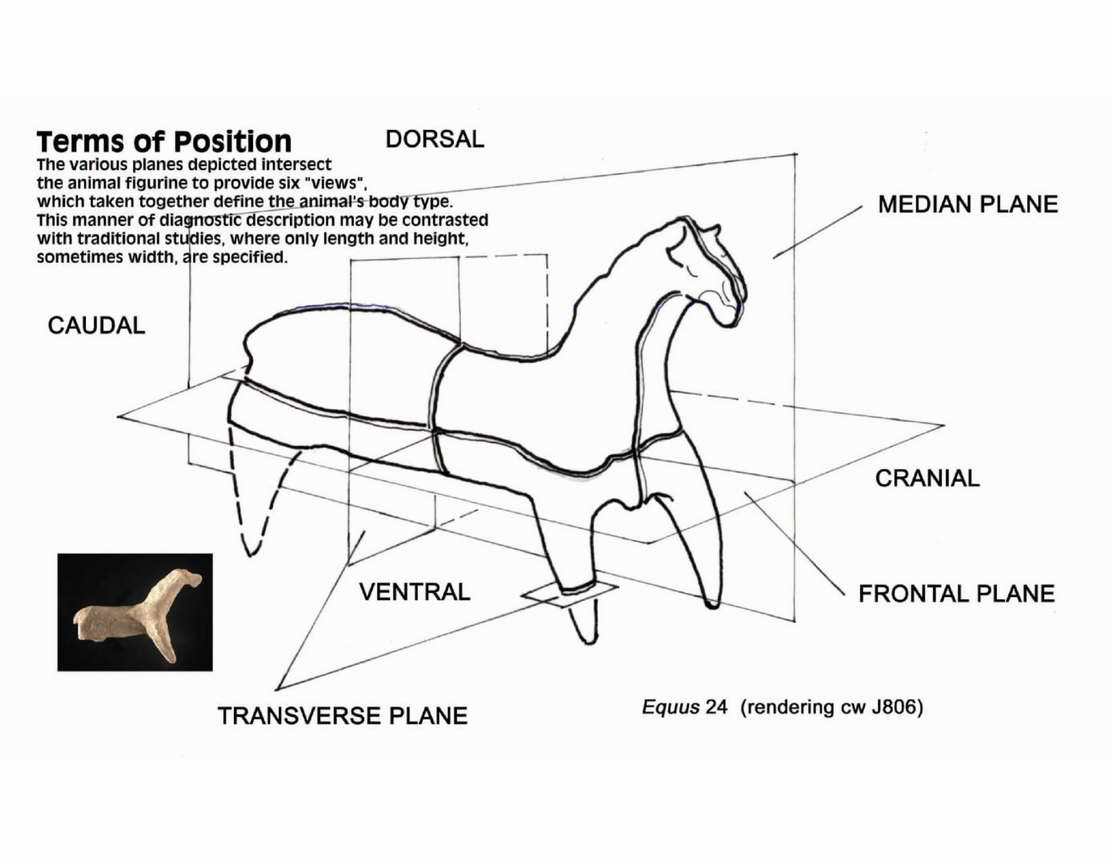Measuring figurines
Background
The Urkesh system
Bibliography
Background
Figurines – and certainly many other types of artifacts – may be described in detail in archaeological studies. In the case of an intricately elaborated animal figurine, this description may suffice to distinguish the representation from other examples of the animal form depicted.
If our aim is full description, medium, color, texture, type of surface decoration, stylistic considerations, etc. – what we could call secondary characteristics – may contribute to our understanding and are therefore noted.
Seldom, however, does measurement, except in terms of gross size, play a part in our definition of the type of object or its description. As a rule, length and height are the only measurements taken. Occasionally width is specified. Where exactly these measurements are taken, from what point to what point, is seldom made clear. This might be important, for example, if an equid were at rest or in action or if standing, the legs were extended. Where in fact does the body of the animal representation begin and end? If an object is broken, missing appendages, could measurement ever be diagnostic?
These and similar questions began to be important to Claudia Wettstein, my draftsman/artist colleague, and me as we were faced with an ever-mounting assortment of what appeared to be animal representations, all very similar. The difficulty in differentiating amongst them was further complicated by breakage. Deposition in the ground had taken its toll; the figures often were missing an appendage, two appendages – all appendages, including the tail. Almost never were we lucky enough to find an animal with its head on.
Even within a class of readily identifiable artifacts, say, horse and rider, from the second millennium and later, what does distinguish one object from another? Secondary characteristics, assuredly – this example may have a bridle, the rider a beard or cap. And usually the height and length of the object are dutifully noted.
Might there be other information that would be useful in establishing a typology of similar objects from a given period?
|
Back to top
The Urkesh system
In the case of animal figurines, at least, I believe that we have ignored one of the most useful and obvious diagnostic tools – measurement of body parts and, further, ratio and proportion of the given body part to other parts of the animal anatomy. These measurements have become for me, primary characteristics, rather than obligatory notations without any particular meaning other than classification by size – a "large horse", a "larger horse", the "largest of the lot", etc.
When we render or photograph the Urkesh animal figurines at Tell Mozan, we represent six views, taken on a quadruped in normal standing position:
|
- dorsal
(frontal plane, from above)
- ventral
(frontal plane, from below)
- cranial
(forequarters, transverse segmental vertical section)
- caudal
(hindquarters, transverse segmental vertical section)
- left median
(vertical longitudinal section)
- right median
(vertical longitudinal section)
|

|
By examining the artifact in each of these views, taken separately at first, we are able to isolate certain characteristics and see, after a time, similarities of body structure.
Where does this terminology come from? We have borrowed the approach to anatomical analysis from veterinarians, scientists whose very specialty is the adequate and accurate description of anatomical normalcy and variants from this norm in order to heal or nurture animals. Our end is different, of course. We aim to describe and define different types of animals as represented in the Urkesh corpus. A typology hopefully is the end result of such exhaustive collection of data.
Measurements are taken in the various planes/views described above and the point at which the measurement is taken is usually at the point where the plane intersects the anatomical detail at its greatest extension. It is not unusual for us to take as many as seventeen different measurements of body parts, in order to determine the animal's genus or species by comparison with other examples from the sample.
Other attributes – secondary characteristics – can also be telling. Some are definitive. Measurement, however, is the underpinning of the typology I have established.
How else might one accurately give meaning to the shattered clay remnants of what Urkesh artisans must have meant to represent as a living animal?
|
Back to top
Bibliography
Back to top
